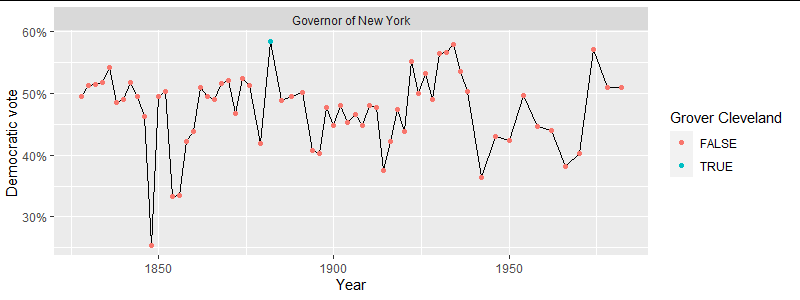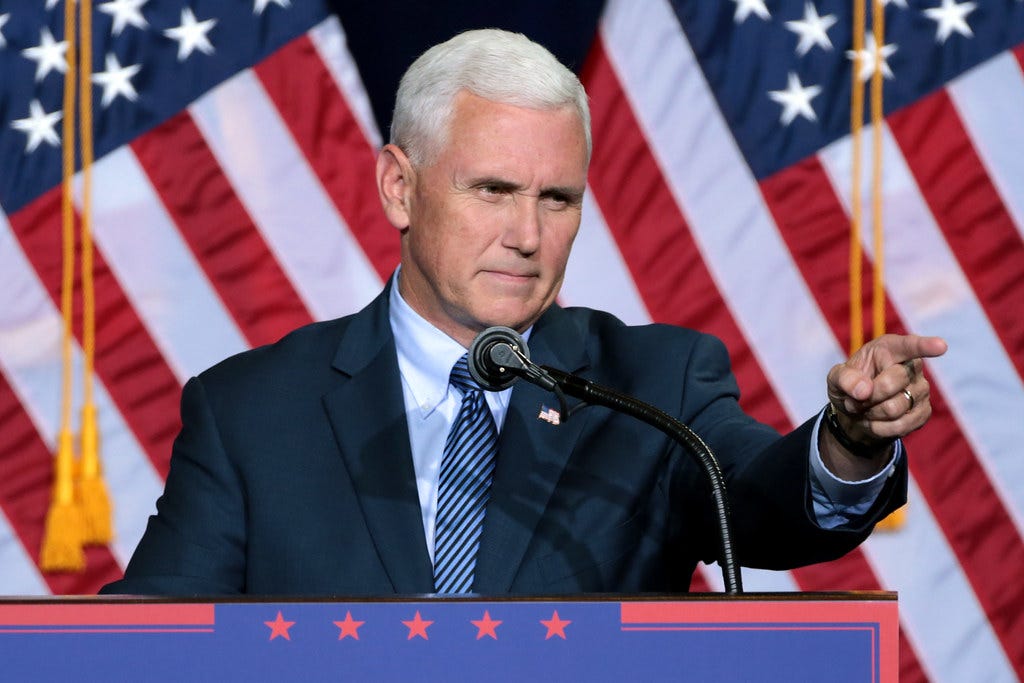In the first installment, I talked about some of the Republican candidates who are least linked to the last Republican presidential administration: Current sitting governors. Next, I’ll start looking at the Republicans who served in the Trump administration and seem likely to run.

The Trump White House played host to five people who are seen as likely presidential contenders. This includes the former president himself, the former Vice President Mike Pence, former UN Ambassador Nikki Haley (who officially announced her candidacy on February 14th), former Secretary of State Mike Pomeo, and former National Security Advisor John Bolton.
In this piece, I’ll discuss the electability of these candidates using a composite measure, similar to how I did it in part 1 of this series. In this installment, I’ll add some discussion of the background of candidates, using insights that I’ve picked up about past presidential elections from the research I did for my book on the Electoral College. (If you haven’t picked it up yet, you should - it’s a good book, if I say so myself.)
Donald Trump
While incumbent presidents generally have an advantage in running for re-election, former presidents trying to return for a non-consecutive term have a more mixed record. This has been attempted four times (1848, 1856, 1892, and 1912) and it has gone badly three out of four times. The exception is Grover Cleveland, who is best known today as the only president who ever served two non-consecutive terms.
Grover Cleveland’s political career began in New York. Running for governor in 1882, he won a whopping 58.5% of the vote in what was, at the time, a closely-contested battleground state. This was the largest margin of victory by any candidate for governor of New York since 1822, when Joseph Yates ran without any organized opposition.
No candidate for governor of New York with an opponent supported by a major party had ever earned 58.5% of the vote. In fact, no subsequent candidate for governor of New York earned a higher share of the vote until incumbent Mario Cuomo in 1986. Grover Cleveland was the single most successful gubernatorial candidate New York had from 1789 to 1982.

Out of the thirteen presidential elections from 1860 to 1908, Democratic presidential candidates won the popular vote only four times. Grover Cleveland accounted for three of these popular vote victories. (The fourth, Samuel Tilden, lost in 1876.) Cleveland was only unseated in 1888 because of an electoral fluke, a rare Electoral College reversal fueled by widespread election fraud in New York City.
Donald Trump decisively lost the national popular vote twice. In 2016, this happened in spite of the fact that his opponent, Hillary Clinton, polled consistently underwater in favorable numbers. He has never won a majority in any election for public office. He only became president through a rare fluke of the Electoral College system, one that was not repeated in 2020 and is not very likely to be repeated in 2024.
Thus far, only one candidate has been put up for nomination by a major party after losing the popular vote twice… and William Jennings Bryan’s third presidential run failed as decisively as his first two attempts. It is not impossible for Trump to win; but Republicans would be running a higher risk of failure by choosing to nominate Trump again. Polls show little sign that Trump’s unpopularity has abated.
Mike Pence
Mike Pence has not officially filed to run, but he is widely expected to run. Historically, former vice presidents have a fairly strong track record, winning seven out of twelve contests. There isn’t much evidence that this is due to incumbency; Richard Nixon won eight years after leaving office and Joe Biden won four years after leaving office.

Mike Pence also has previous executive experience at the state level as governor of Indiana; but this is where he begins to look weak. Indiana is not very large, and not a recent battleground state. Additionally, when he was elected in 2012, he did poorly at the ballot box, trailing behind Republican presidential candidate Mitt Romney as well as most other Republicans running in Indiana in 2012.
Similarly, while his approval ratings as a governor of a Republican-leaning state were mostly positive, he exited office with a net approval rating near 0% - not very impressive in a state that generally favors Republicans. His successor, Eric Holcomb, had net approval ratings that consistently exceeded +20%.

There is one X factor potentially in his favor: He did visibly stand up to Donald Trump during the critical transition period at the end of Trump’s presidency. The January 6th Commission highlighted the importance of Pence’s commitment to the constitutional process over loyalty to Trump. In general, the 2022 election results showed strong general election performances from Republicans who stood up in favor of electoral integrity and against Trump’s attempts to reverse the 2020 election results, such as Georgia Secretary of State Brad Raffensperger.
Nikki Haley
People who most recently served as ambassadors or ministers have won two out of five attempts at the presidency (William Henry Harrison and James Buchanan), a success rate similar to governors. (She may be better known as a governor in any event.) Like Mike Pence, Nikki Haley was the governor of a Republican state that is unlikely to be a battleground in 2024, and does not have a helpful home state edge.
Also like Mike Pence, her electoral performance as governor was lackluster. In 2014, she underperformed other Republicans on the ballot in South Carolina by a significant margin. However, unlike Mike Pence, she left office with a high approval rating, even after adjusting for partisanship.
One potential X factor for Nikki Haley is identity. In more recent cycles, Democrats have tended to paint Republicans as being racist and sexist, and this is a more difficult line of attack against a non-white woman whose parents were both immigrants. Additionally, there’s some evidence that suggests that Republican women are seen as more moderate, providing them with an advantage with swing voters in the general election.
Mike Pompeo & John Bolton
Historically, the secretaries of the Cabinet have had a strong record, winning five of eight attempts. However, it is worth noting that the successful candidates coming out of the Cabinet have done so with the support of their former bosses. Most of those runs came from the pre-LBJ period, when the vice president was seen more as a legislative officer and unlikely to be a president’s apparent successor.
In addition to the low level of confidence in the value of their prior political experience as Cabinet members, neither Pompeo nor Bolton have ever run in a statewide election. Their offices were not prominent enough to be the topic of regular approval polling that could be used to calibrate their popularity relative to baseline partisanship. For now, I’ll mark both of them as unknowns - this early in the cycle, it’s hard to put together good enough information to do the kind of quantitative analysis I’m doing on either Pompeo or Bolton.
Composite scores
In this article and the previous one, we’ve referred to five numerically quantifiable scores that can be applied to nine out of the eleven candidates discussed. Multiplying these scores by reasonable constants and adding them together gives us a reasonable and quantitatively-grounded electability score.
As a mathematical note, reasonable constants for combining different types of scores are usually close to normalizing constants, i.e., ones similar to the inverse of the standard deviation of the distribution of each type of score. This gives each independent factor a similar impact on the composite score. I’ve chosen values close to the standard deviation for the first three scores, and close to half of that for the electoral performance measures, since there are two of them and they are closely correlated.
In an effort to keep Donald Trump’s negatives from dominating analysis, and to pre-emptively defend this article from charges of underestimating Donald Trump’s ability to perform in a general election, I’ve chosen to shift away from the electoral performance measure using raw vote totals relative to median performance and shift towards ones that either use percentages relative to median performance (A) or at least divide by the square root of the population (B).
In Donald Trump’s case, the “median Republican performance” in the same election is generously calculated as being the halfway point between his own performance and that of Republican candidates running for the House of Representatives. I’ve also granted him the most valuable home state edge that anyone could reasonably assign him given his history: Florida. Trump nevertheless falls to the bottom of the table with a score of 23, just below Kristi Noem’s score of 29.
Nikki Haley and Mike Pence, with scores of 50 and 44, join Greg Abbott with his score of 44 in the middle of the pack. This is because while there are some reasons to regard them as serious contenders, they have mixed indicators that include a weak track record on the campaign trail as governors.
The top of the table is dominated by the governors I highlighted in the first installment of this series, which is reasonable: Popular governors of key battleground states historically have been very strong presidential candidates. This list starts with Chris Sununu (92), Brian Kemp (80), Glenn Youngkin (78), and ends with Ron DeSantis (70). This isn’t the final word, though; I’ll be adding more information in the third installment of the series, so stay tuned.




